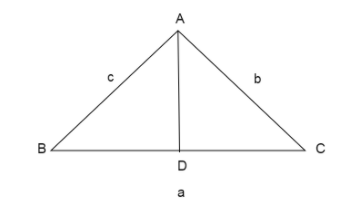
Find the length of the bisector of angle A in a triangle ABC.
A. \[\dfrac{{2bc\sin (A/2)}}{{b + c}}\]
B.$\dfrac{{2bc\cos (A/2)}}{{b + c}}$
C. $\dfrac{{abc}}{{2R(b + c)}}\csc (A/2)$
D. $\dfrac{{4\Delta }}{{b + c}}\csc (A/2)$
Answer
580.2k+ views
Hint: Here the properties of bisector are the only information which we use to reach the solution, which are as follows:
* Bisector of an angle A is defined to be the line cutting off A into equal halves which meets the
opposite side. In the below figure, AD is the bisector of angle A. Thus it divides angle A into 2 equal
halves and meets the opposite side BC.

* Bisector of an angle of a triangle divides the opposite side in the ratio of the sides containing the angle.
Implies point D divides BC into the ratio of sides containing angle A which are AC and AB. Thus
$\dfrac{{BD}}{{DC}} = \dfrac{{AC}}{{AB}}$
* Sine rule: Ratios of a side to corresponding opposite angles are equal. $\dfrac{{AB}}{{\sin C}} = \dfrac{{AC}}{{\sin B}} = \dfrac{{BC}}{{\sin A}}$
Complete step-by-step answer:
We start with bisector AD and develop its relation with the interior angles.
Sine rules on the triangle ABD gives the result: $\dfrac{{AD}}{{\sin B}} = \dfrac{{BD}}{{\sin (A/2)}}$
From the property of bisector and sine rule, $BD = \dfrac{c}{{b + c}}a$
$AD = \dfrac{{ca}}{{b + c}}\dfrac{{\sin B}}{{\sin (A/2)}}$
Multiplying numerator and denominator by $2\cos (A/2)$, for simplifying the equation to shorter terms.
$AD = \dfrac{{ca.\sin B.2\cos (A/2)}}{{(b + c)\sin (A/2).2\cos (A/2)}}$
Using the formula $\sin (2\theta ) = 2\sin \theta \cos \theta $ ,
$AD = 2.\dfrac{{ca.\sin B.\cos (A/2)}}{{(b + c)\sin A}}$
Using sine rule: $\dfrac{a}{{\sin A}} = \dfrac{b}{{\sin B}}$ we get,
$
AD = 2.\dfrac{{cb\sin B\cos (A/2)}}{{(b + c)\sin B}} \\
= \dfrac{{2cb\cos (A/2)}}{{b + c}} \\
$
From the property of bisector and sine rule,
$AD = \dfrac{{2bc}}{{b + c}}\dfrac{{\cos (A/2)\sin (A/2)}}{{\sin (A/2)}}$
Simplifying,
$AD = \dfrac{{bc}}{{\sin (A/2)}}\dfrac{{\sin A}}{{\sin (A/2)}}$
Using $\sin A = \dfrac{a}{{2R}}$ , $\dfrac{1}{{\sin (A/2)}} = \csc (A/2)$ we get,
$AD = \dfrac{{abc}}{{2R(b + c)}}\csc (A/2)$
As $R = \dfrac{{abc}}{{4\Delta }}$
$AD = \dfrac{{abc.4\Delta }}{{2abc(b + c)}}\csc (A/2)$
Simplifying,
$AD = \dfrac{{2\Delta }}{{b + c}}\csc (A/2)$
So, the correct answer is “Option B” and “Option C”.
Note: Students are likely to make mistakes while substituting the sides using the sine formula, always keep in mind the angle opposite to the side comes in denominator along with the side in the numerator. Making the rearrangements of terms according to our motive is to be done properly for a quick solution. Multiplying and dividing by needed trigonometric terms can cut short the solution into simpler form lines.
* Bisector of an angle A is defined to be the line cutting off A into equal halves which meets the
opposite side. In the below figure, AD is the bisector of angle A. Thus it divides angle A into 2 equal
halves and meets the opposite side BC.

* Bisector of an angle of a triangle divides the opposite side in the ratio of the sides containing the angle.
Implies point D divides BC into the ratio of sides containing angle A which are AC and AB. Thus
$\dfrac{{BD}}{{DC}} = \dfrac{{AC}}{{AB}}$
* Sine rule: Ratios of a side to corresponding opposite angles are equal. $\dfrac{{AB}}{{\sin C}} = \dfrac{{AC}}{{\sin B}} = \dfrac{{BC}}{{\sin A}}$
Complete step-by-step answer:
We start with bisector AD and develop its relation with the interior angles.
Sine rules on the triangle ABD gives the result: $\dfrac{{AD}}{{\sin B}} = \dfrac{{BD}}{{\sin (A/2)}}$
From the property of bisector and sine rule, $BD = \dfrac{c}{{b + c}}a$
$AD = \dfrac{{ca}}{{b + c}}\dfrac{{\sin B}}{{\sin (A/2)}}$
Multiplying numerator and denominator by $2\cos (A/2)$, for simplifying the equation to shorter terms.
$AD = \dfrac{{ca.\sin B.2\cos (A/2)}}{{(b + c)\sin (A/2).2\cos (A/2)}}$
Using the formula $\sin (2\theta ) = 2\sin \theta \cos \theta $ ,
$AD = 2.\dfrac{{ca.\sin B.\cos (A/2)}}{{(b + c)\sin A}}$
Using sine rule: $\dfrac{a}{{\sin A}} = \dfrac{b}{{\sin B}}$ we get,
$
AD = 2.\dfrac{{cb\sin B\cos (A/2)}}{{(b + c)\sin B}} \\
= \dfrac{{2cb\cos (A/2)}}{{b + c}} \\
$
From the property of bisector and sine rule,
$AD = \dfrac{{2bc}}{{b + c}}\dfrac{{\cos (A/2)\sin (A/2)}}{{\sin (A/2)}}$
Simplifying,
$AD = \dfrac{{bc}}{{\sin (A/2)}}\dfrac{{\sin A}}{{\sin (A/2)}}$
Using $\sin A = \dfrac{a}{{2R}}$ , $\dfrac{1}{{\sin (A/2)}} = \csc (A/2)$ we get,
$AD = \dfrac{{abc}}{{2R(b + c)}}\csc (A/2)$
As $R = \dfrac{{abc}}{{4\Delta }}$
$AD = \dfrac{{abc.4\Delta }}{{2abc(b + c)}}\csc (A/2)$
Simplifying,
$AD = \dfrac{{2\Delta }}{{b + c}}\csc (A/2)$
So, the correct answer is “Option B” and “Option C”.
Note: Students are likely to make mistakes while substituting the sides using the sine formula, always keep in mind the angle opposite to the side comes in denominator along with the side in the numerator. Making the rearrangements of terms according to our motive is to be done properly for a quick solution. Multiplying and dividing by needed trigonometric terms can cut short the solution into simpler form lines.
Recently Updated Pages
Master Class 10 General Knowledge: Engaging Questions & Answers for Success

Master Class 10 Computer Science: Engaging Questions & Answers for Success

Master Class 10 English: Engaging Questions & Answers for Success

Master Class 10 Social Science: Engaging Questions & Answers for Success

Master Class 10 Maths: Engaging Questions & Answers for Success

Master Class 10 Science: Engaging Questions & Answers for Success

Trending doubts
Which of the following does not have a fundamental class 10 physics CBSE

10 examples of evaporation in daily life with explanations

State and prove the Pythagoras theorem-class-10-maths-CBSE

State BPT theorem and prove it class 10 maths CBSE

What is UltraEdge (Snickometer) used for in cricket?

What are the public facilities provided by the government? Also explain each facility




